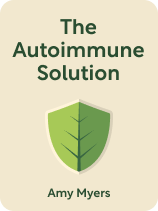

This article is an excerpt from the Shortform book guide to "The Autoimmune Solution" by Amy Myers. Shortform has the world's best summaries and analyses of books you should be reading.
Like this article? Sign up for a free trial here.
Where do environmental toxins come from? How do toxins affect your immune system?
Amy Myers, the author of The Autoimmune Solution, explains the effects that toxins, both environmental and chemical, can have on your body. She provides four examples of the types of toxins in question.
Here’s a deeper look into toxins and their health risks.
Toxins and the Immune System
Myers explains toxins and the health risks they pose to your body. First, toxins can reduce the production of cells that regulate your immune system.
Second, toxins can confuse your immune system, weakening its ability to distinguish between foreign tissue and your own body. This happens when toxins overstimulate your immune system. It also happens when toxins alter or damage cells in your body so your immune system no longer recognizes them as part of your body.
(Shortform note: Toxins that confuse the immune system or reduce the production of regulatory immune cells can contribute to a range of health issues beyond autoimmune diseases. For instance, exposure to environmental toxins, such as heavy metals and persistent organic pollutants, has been linked to increased risks of cardiovascular diseases, metabolic disorders, and even certain cancers. This happens because environmental toxins induce chronic inflammation in the body.)
Environmental toxins come from multiple sources—we’ll discuss four of them. The first source is water containing fluoride and chlorine.
(Shortform note: Fluoride and chlorine are commonly added to drinking water as a result of public health policies. Water treatment plants use chlorine to kill potential germs. Public health organizations credit water chlorination with reducing waterborne diseases like dysentery. Some localities add fluoride to their water to reduce tooth decay. A 2010 study showed that drinking fluoridated water as a child reduces tooth loss in middle age. However, there are concerns about long-term health effects and potential overexposure, which might weaken bones and cause cognitive issues in children.)
Secondly, environmental toxins are found in toiletries. These products contain harmful ingredients like parabens, phthalates, and heavy metals.
(Shortform note: In addition to causing autoimmune conditions, toxins in toiletries can contribute to a host of other illnesses. In The Plant Paradox, Steven Gundry argues that endocrine disruptors in common personal care products can cause reproductive issues, cancer, and impaired brain and neuroendocrine system development. They can also lead to vitamin D deficiency, which contributes to obesity and osteoporosis.)
Toxins are also found in a third source: food. For example, food can contain pesticides, heavy metals (especially fish), and chemicals leached from plastic containers and non-stick cookware.
(Shortform note: Myers encourages you to stop using non-stick cookware, and you might want to re-evaluate the tools you’re using on your non-stick pan as well. Research suggests that black plastic utensils, like the spatula you might use to avoid scratching a non-stick pan, may contain toxic chemicals. These toxins include flame retardants, which can leach into food during cooking. Opt instead for stainless steel, silicone, wood, or bamboo utensils.)
Finally, indoor areas are sources of toxins. Homes can house toxins from building materials, furniture, carpeting, and mold growth. Indoor air can contain chemicals from cleaning products and building materials.
| How Racist Systems Expose Black Americans to More Toxins While Myers emphasizes that all of us are exposed to more toxins than our bodies can safely process, some groups are disproportionately harmed by toxins. In The 1619 Project, journalist Nikole Hannah-Jones writes that specific economic policies promoted at the local, state, and federal levels in the United States have made Black Americans more prone to illness than white Americans. She writes that policies developed during the 19th and 20th centuries by white elected officials, city planners, and mortgage bankers forced Black Americans into segregated neighborhoods. City planners then targeted these Black neighborhoods for highway construction, which caused overcrowding and pollution. The combination of overcrowding, a lack of clean outdoor places like parks, and poor air quality from passing traffic exposed residents to harmful toxins in the air inside and around their homes. In The Color of Law, Richard Rothstein adds that industrial zoning laws have contributed to overcrowding and pollution in Black neighborhoods. These laws specifically zone areas in or near Black neighborhoods for industrial plants and factories, even though the chemicals from these plants are believed to cause major health issues. In addition, low housing quality exposes Black Americans to toxins inside their homes. Black children have the highest average blood lead levels compared to other racial groups in the US. Experts argue this exemplifies environmental racism, where harmful government and private sector policies impact minority communities more severely, causing them to live and work in more polluted environments. Moreover, writes Hannah-Jones, healthy food is harder to find in Black neighborhoods, where mini-markets selling processed food proliferate. Processed food is more likely to contain toxins like heavy metals and pesticides from its ingredients and packaging. One 2013 study shows that the more impoverished a neighborhood was, the fewer supermarkets and fresh, nutritious, and low-fat meal and snack options were available—and these findings were especially true in predominantly Black areas. For as long as these issues have persisted, Black Americans have fought for safer living conditions and better access to healthy food. For example, Black farmers are working to improve access to healthy food in their communities. In addition, Black-led environmental organizations are rallying residents of communities impacted by pollution to oppose the construction of hazardous facilities in their neighborhoods. |

———End of Preview———
Like what you just read? Read the rest of the world's best book summary and analysis of Amy Myers's "The Autoimmune Solution" at Shortform.
Here's what you'll find in our full The Autoimmune Solution summary:
- How to prevent or even reverse autoimmune diseases with lifestyle changes
- A comparison of traditional vs. functional medicine approaches to autoimmune diseases
- The Myers' Method for strengthening and balancing your immune system






